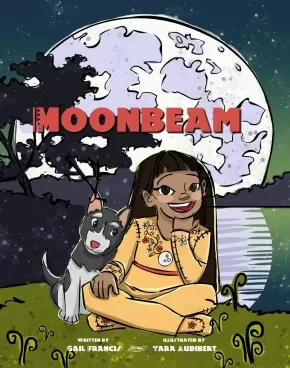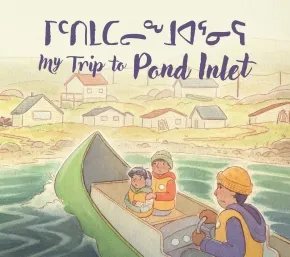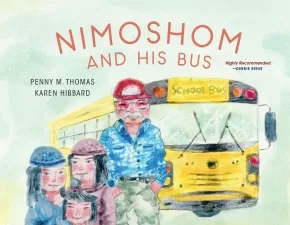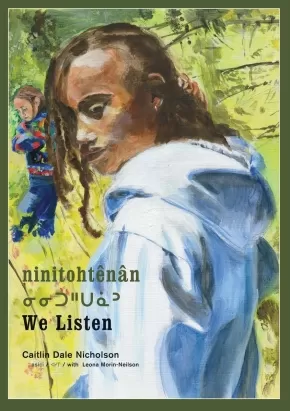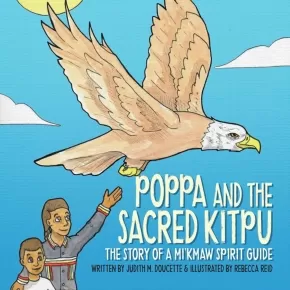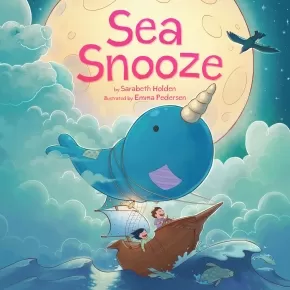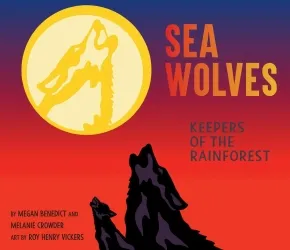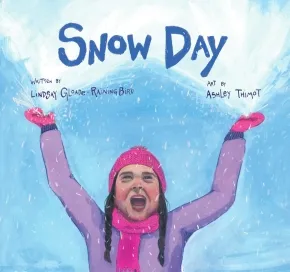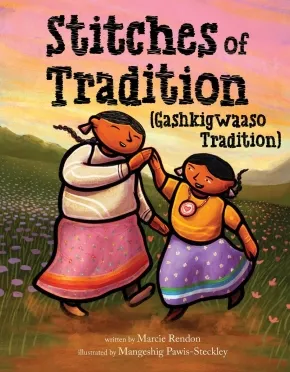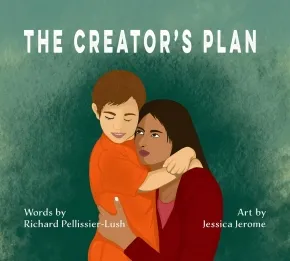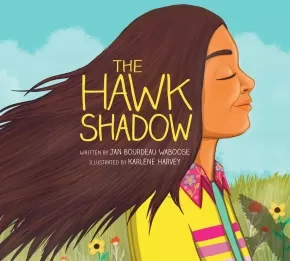
Indigenous Peoples in Canada
121
-
135
of
437 Results;
Sort By
Go To
of 30
Moonbeam
$14.95
Format:
Paperback
Text Content Territories:
Indigenous Canadian; First Nations; Wolastoqiyik (Maliseet);
ISBN / Barcode: 9781777854294
Synopsis:
Synopsis:
How did you get your name? Who named you? Why were you given your name? How do we name our children? Using the traditional practice of naming children, this first story about Moonbeam is the story of how she got her name. She tags along with her mother Morning Star to deliver a baby and she tries to guess the new baby’s name.
Awards
- 2020 Dr. Marilyn Trenholme Literacy Award for Outstanding Effort in Indigenous Literacy winner
- 2023 Lieutenant-Governor's Award for High Achievement in the Arts
Reviews
“This altogether lovely story takes us into the heart of family and community. The naming of things is the claiming of things. The arrival and naming of a child is celebration!” - Sheree Fitch – Canadian Author
Educator & Series Information
Recommended for ages 4 to 10.
This book is the first book in the Moonbeam series, followed by Moonbeam Meets the Medicine Man.
Additional Information
28 pages | 7.28" x 9.25" | Paperback | 2nd Edition
My Trip to Pond Inlet
$16.95
Artists:
Format:
Paperback
Text Content Territories:
Indigenous Canadian; Inuit;
ISBN / Barcode: 9781774507728
Synopsis:
Synopsis:
One rainy day, Solomon is playing inside with his sister. Their mom is cooking polar bear meat in a big pot of water. Suddenly, he trips and burns his arm in the pot of boiling water! The burn is so bad that he must travel to the health centre in the neighbouring community of Pond Inlet. Solomon has to stay in Pond Inlet until his arm heals. Even though Solomon misses his home, he likes playing with the other kids at the health centre and exploring the new and exciting community of Pond Inlet.
Educator & Series Information
Recommended for ages 5 to 7.
In My Trip to Pond Inlet children learn about the responsibility of being safe around hot water and taking care of themselves after an injury.
Dual-Language: English and Inuktitut
This book is part of the Community Connections series.
Additional Information
40 pages | 9.00" x 10.00" | Paperback
Nimoshom and His Bus (PB)
$14.00
Artists:
Format:
Paperback
Text Content Territories:
Indigenous Canadian; First Nations; Cree (Nehiyawak);
Grade Levels: Preschool; Kindergarten;
ISBN / Barcode: 9781774921166
Synopsis:
Synopsis:
In this warm and joyful picture book highly recommended by Debbie Reese, children learn Cree from Nimoshom, their school bus driver.
Based on the author’s memories of her grandfather, Nimoshom is not your average bus driver. He loves to drive the school bus, tell silly stories, and share his language with the kids who ride his bus.
Nimoshom and His Bus introduces readers to common Cree words and phrases alongside the common childhood experience of riding the school bus. A Cree word list is included in the back of the book.
Reviews
"Through accessible language and engaging visual resources, readers are introduced to basic Cree as Nimoshom responds in this language to the children who ride his bus.... The illustrator’s varying the visuals between full double spreads and single page illustrations keeps the pacing lively. Amidst a rural fall setting, with woodland animals, children, and the school bus, Nimoshom’s humorous nature shines through these gentle illustrations. At the end of this story, you just want to give Nimoshom a great big hug!"— Anita Miettunen, CM: Canadian Review of Materials
"In this bilingual book, readers follow a bus driver picking up kids and dropping them off before and after school. Like the students on the bus, readers quickly learn that the driver's native language is Cree, and he often speaks to them in his native language. Readers learn that "Nimoshom" means "my grandfather" and that "Ekosani" means thank you" as the author (of Cree descent herself) weaves Cree words into the text, and each new spread almost feels like a gentle wave: yes, we're subtly learning new words, but it never feels strenuous or forced, rather it's calm and poetic."— Let's Talk Picture Books
"While Penny M. Thomas' story is not a plot-driven allegory or a message-based lesson, Nimoshom and His Bus is a sweet introduction to some simple Cree words in the context of a common-place activity for many children.... Karen Hibbard who uses watercolours and pastels to create a gentle background for Nimoshom's day on his bus gives the story a grassroots mood, highly appropriate for a routine day of activity and interaction for this bus driver and his charges. It's very relatable."— Helen Kubiw, CanLit for Little Canadians
"If you're a regular reader of AICL, you know that we're always delighted by books by Native writers--especially ones set in the present. Books like Nimoshom and His Bus provide Native children with mirrors that non-Native children find in abundance.... I highly recommend Nimoshom and His Bus! It'd be a simple thing to use other Native words in addition to--or instead of--the Cree words in the book."— Debbie Reese, American Indians in Children's Literature
Educator Information
Recommended for ages 3 to 5.
Additional Information
24 pages | 9.50" x 7.50" | Paperback
ninitohtênân / We Listen
$21.99
Artists:
Format:
Hardcover
Text Content Territories:
Indigenous Canadian; First Nations; Cree (Nehiyawak);
ISBN / Barcode: 9781773068596
Synopsis:
Synopsis:
The third book in the Nôhkom series, in Cree and English, tells a story about gathering leaves for Labrador tea, while listening in different ways.
A child, her family and her friend have arrived at their favorite picnic spot by the lake, but before they eat lunch Nôhkom suggests they pick leaves for Labrador tea. Once among the trees, Nôhkom pauses for a moment to listen, and the others do too. Nôhkom prays, the girls take their turn, then Nôhkom shows them where to find the leaves. Nôhkom and Mom rest after harvesting, but the girls opt for a swim in the lake ... though they're quite happy to warm up afterwards with freshly brewed Labrador tea. And when it's time for the picnic, the girls take another turn at listening.
Beautifully rendered paintings in acrylic on canvas show the family outing. Includes a recipe for Labrador tea as well as a salve made from Labrador Tea leaves.
Educator Information
Recommended Ages: 3 to 7.
Written in short sentences in Cree and English (with Cree text appearing in standard roman orthography and syllabics), the book is a good choice for beginning readers and/or language learners.
This book is the third book in the Nôhkom series.
The story features different forms of listening — in the bush, to teachings from Nôhkom, to the conversation of family and friends (when listening can be especially fun!).
Key Text Features
illustrations
recipe
informational note
Correlates to the Common Core State Standards in English Language Arts:
CCSS.ELA-LITERACY.RL.1.2
Retell stories, including key details, and demonstrate understanding of their central message or lesson.
CCSS.ELA-LITERACY.RL.1.7
Use illustrations and details in a story to describe its characters, setting, or events.
Authenticity Note: Translator Leona Morin-Neilson is the inspiration for the stories and art in the Nôhkom series, which highlights her traditional knowledge of the uses of wild plants. She collaborated with the author to create this work and translated it into Cree.
Because of the collaboration between Leona and the author, and Leona's Cree translation, this book has been labelled as containing Authentic Indigenous Text. It is up to readers to determine if this work is authentic for their purposes.
Additional Information
24 pages | 8.50" x 12.25" | Hardcover
Poppa and the Sacred Kitpu
$18.95
Artists:
Format:
Paperback
Text Content Territories:
Indigenous Canadian; First Nations; Mi'kmaq;
ISBN / Barcode: 9781774571859
Synopsis:
Synopsis:
After being invited into his grandson’s school to share his wisdom and knowledge of his traditional Mi’kmaw culture in Poppa and His Drum, Poppa is happy to return as a respected Indigenous Elder and Knowledge Keeper.
In this second book of the Poppa series, we find Poppa giving his next gin’masuti (lesson in our culture) to his grandson, François, and his friends, Paul and Joe.
The boys have an important art project to complete for school and are not sure what to do. While spending the afternoon on a beach adventure with Poppa, the boys get to learn about the Sacred Kitpu (Bald Eagle) and why it’s so important to our Indigenous People.
Poppa engages the children with eager imaginations of how the Sacred Kitpu is not only a powerful spirit guide, but also represents the Spirit of the Creator among us. It is the messenger between Mother Earth and the Spirit World, whispering to the Creator our prayers, touching the face of the Creator with its wing.
Poppa teaches the children through mystic wonder how we use the Sacred Kitpu feather in many different cultural ceremonies. He embraces their eagerness to learn and shares the tradition of smudging, using the Kitpu feather along with Sacred Medicines that burn in a smudge bowl to purify our body, mind, and spirit.
The children delight in discovering Poppa’s never-spoken-of regalia treasures that once belonged to his grandfather and decide to commemorate their art project to the Sacred Kitpu.
Poppa is invited back to the class to award the winning medal to the winners of the arts project. He is proud to present the medals to happy children who truly understand and appreciate the importance of the role the Sacred Kitpu plays in our Mi’kmaw culture and heritage. Poppa and the Sacred Kitpu will delight and surprise the reader with fun and teachings given by the love of a Poppa who is cherished by his community for being such a wonderful Mi’kmaw Elder.
Educator & Series Information
Recommended for ages 5 to 12.
This book is the second book in the Poppa series, following Poppa and His Drum.
Additional Information
9.00" x 9.00" | Paperback
Sanirajak, A Place I Love
$16.95
Artists:
Format:
Paperback
Text Content Territories:
Indigenous Canadian; Inuit;
ISBN / Barcode: 9781774507704
Synopsis:
Synopsis:
Alice loves her community, and she's excited to show others her favourite things to see and do throughout the year. From ice fishing to collecting clams to cheering on hunters in the community, there is always something to enjoy in Sanirajak.
Educator & Series Information
Recommended for ages 5 to 7.
Dual-Language: English and Inuktitut
Readers will learn about different activities people do in each season in Sanirajak, Nunavut in Sanirajak, a Place I Love.
Sanirajak, a Place I Love teaches about the values of community and sharing food with community members after a hunt.
This book is part of the Community Connections series.
Additional Information
36 pages | 9.00" x 10.00" | Paperback
Sea Snooze
$22.95
Artists:
Format:
Hardcover
Text Content Territories:
Indigenous Canadian; Inuit;
Grade Levels: Preschool; Kindergarten;
ISBN / Barcode: 9781772275186
Synopsis:
Synopsis:
“All aboard our little boat!
We’ll sail all night.
Let’s see where we float!”
Full speed ahead as two siblings sail off for dreamland! Before these two can settle down under the covers, they cruise off onto the Arctic Ocean to bid goodnight to narwhals and guillemots, mikes and belugas. They sail past clouds shaped like polar bears and marvel at the multitudes of stars that twinkle between them. Before dawn pulls them back to their own cozy bedroom, they snack with the seals on the bow of their ship, waving goodbye as from dreamland to daytime they go.
Educator Information
Recommended for ages 3 to 5.
Additional Information
32 pages | 9.50" x 9.50" | Hardcover
Sea Wolves: Keepers of the Rainforest
$24.99
Format:
Hardcover
Text Content Territories:
Indigenous American; Indigenous Canadian;
ISBN / Barcode: 9781662620119
Synopsis:
Synopsis:
This lyrical, stunningly illustrated book explores the sea wolf—an apex marine mammal evolved from the gray wolf—as it navigates the coastline, eats seafood, and lives its extraordinary, unusual life.
Sea Wolves: Keepers of the Rainforest is the astonishing story of a wolf species that calls the shores of western Canada and southeastern Alaska home. Here, wolves crack clams, feast on fish roe, swipe salmon from rivers, and swim miles between islands—as long observed by the First Nations communities that have lived alongside them for thousands of years.
However, with the rise of industrial logging, pipeline projects, and other threats, sea wolves face a troubled future. Wildlife experts and First Nations members agree: these majestic creatures are a vital part of the ecosystem and need to be protected.
Through beautiful verse and striking illustrations, Sea Wolves captures the fascinating life of an animal with great cultural and scientific significance—one that will inspire awe in young readers.
Educator Information
Recommended for ages 4 to 8.
Story Locale: Coast of western Canada and southeastern Alaska; British Columbia; First Nations territory
Additional Information
32 pages | 11.31" x 9.81" | Hardcover
Snow Day
$24.95
Artists:
Format:
Hardcover
Text Content Territories:
Indigenous Canadian;
ISBN / Barcode: 9781774713112
Synopsis:
Synopsis:
A joyful, rhyming story in the vein of Ezra Jack Keats's The Snowy Day, this debut children's picture book follows an Indigenous family as they enjoy the magic of a winter storm.
All is quiet on the snow-laden street.
Not a single soul makes a teeny-tiny peep.
Then,
With a bound and a bang and a funny kind of twirl
Out comes a bundled-up joyful little girl.
Capturing the magic of a snowfall, Snow Day follows an Indigenous family as they experience all of the delights of a winter's day. While Mom shovels the driveway and Dad cares for her brother by the fire, a young girl and her dog make snowflake tea, build a snow caterpillar, catch snowflakes on their tongues, and make snow angels. All while the snow continues to fall. At the end of the day, the girl is beckoned inside by the promise of hot chocolate, and regails her family with her adventures' and dreams of doing it all again tomorrow.
Atmospheric, nostalgic, and full of winter fun, the debut picture book by mixed-Cree journalist, book reviewer, and podcast host Lindsay Gloade-Raining Bird is a celebration of Indigenous joy and childhood wonder. Features warm, colourful artwork rendered in traditional gouache and coloured pencil from debut illustrator Ashley Thimot.
Educator Information
Recommended for ages 3 to 7.
Additional Information
32 pages | 10.00" x 9.00" | Hardcover
Sometimes I Feel Like an Oak
$19.99
Artists:
Format:
Hardcover
Text Content Territories:
Indigenous Canadian; First Nations; Anishinaabeg; Algonquin;
ISBN / Barcode: 9781773066981
Synopsis:
Synopsis:
Following the success of Sometimes I Feel Like a Fox and Sometimes I Feel Like a River, this companion book explores the nature and beauty of trees.
Twelve lyrical poems look at twelve different trees, from early spring to deep winter. In each poem, a child identifies with a feature of the tree - such as the smooth trunk of a birch whose bark has peeled away, the strong branches of a spruce that shelter small birds or the pink flowers of a cherry blossom that tumble like confetti. The poems provide an opportunity to learn about each tree, inspiring us to look afresh at the trees around us - whether in the schoolyard, neighborhood or park - and get to know them better.
Danielle Daniel's passion for trees is beautifully matched by Jackie Traverse's paintings, which bring each tree to life. In the pages following the poems, children are invited to consider what different kinds of trees might mean to them. In an author's note, Danielle Daniel shares her belief, similar to her Algonquin ancestors', that trees are sentient beings with much to give and teach us.
Educator & Series Information
Recommended for ages 3 to 6.
This book is part of the Sometimes I Feel Like series.
This book encourages a familiarity with, knowledge about, love of and respect for trees, providers of shade, beauty, oxygen, medicines, food and more.
The text and illustrations show twelve trees from spring through winter, making this a title that could support teaching science units on the seasons.
Key Text Features
illustrations
author's note
poems
Correlates to the Common Core States Standards in English Language Arts:
CCSS.ELA-LITERACY.RL.K.5
Recognize common types of texts (e.g., storybooks, poems).
CCSS.ELA-LITERACY.RL.K.6
With prompting and support, name the author and illustrator of a story and define the role of each in telling the story.
CCSS.ELA-LITERACY.RL.1.4
Identify words and phrases in stories or poems that suggest feelings or appeal to the senses.
Additional Information
32 pages | 8.25" x 10.00" | Hardcover
Stitches of Tradition (Gashkigwaaso Tradition)
$24.99
Format:
Hardcover
ISBN / Barcode: 9780063218680
Synopsis:
Synopsis:
“Noozhishenh, bimadiziwin,” Nookomis says. “My granddaughter, live a good life.”
An Ojibwe grandmother carefully measures and selects just the right colors of fabric, and her sewing machine hums whirr, whirr, whirr late into the night.
In the morning, her growing granddaughter has a beautiful new ribbon skirt to wear, a reminder of her nookomis and the cultural traditions that stitch together her family with love.
This heartwarming story by Marcie Rendon (Ojibwe), with stunning illustrations by Joshua Mangeshig Pawis-Steckley (Ojibwe), celebrates the power of Indigenous craft and community and weaves together the spirit of resilience, female empowerment, and gratitude for the generations that came before us.
Reviews
A radiant and joyful glimpse at an important Native tradition." — Kirkus Reviews (starred review)
"Tradition and love are the core of this picture book...Ojibwe language is seamlessly woven into the dialogue. The digital art fully saturates the pages, layering textures and colors much like the ribbon skirts, and the palette is buoyant and bright, exuding a celebratory feel." — Bulletin of the Center for Children’s Book"s
Educator Information
Recommended for ages 4 to 8.
Detailed text perfect for read-alouds.
Backmatter includes a glossary of Ojibwa terms, more information on ribbon skirts, including history and significance, and infromation about manoomin (wild rice).
Additional Information
40 pages | 8.50" x 11.00" | Hardcover
Tanna's Puppy
$22.95
Artists:
Format:
Hardcover
Text Content Territories:
Indigenous Canadian; Inuit;
ISBN / Barcode: 9781772275520
Synopsis:
Synopsis:
Inspired by a true story!
Tanna's Puppy is the third installment of authors Rachel and Sean Qitsualik-Tinsley's acclaimed series of children's books that explore Rachel's childhood experiences with Arctic animals.
Training dogs has been a strong Inuit tradition for generations. Sled dogs in Inuit communities are valued working animals with a clear and important purpose. Tanna has always known that dogs are not pets. They are not meant to live in houses. Then one day, Tanna is given a puppy to raise as a pet. Dandy is the cutest pup she has ever seen, but Tanna knows her father will not let her keep Dandy as a pet. She eventually convinces her father to let Dandy into the house, just as a test, to see if she can become a good pet. It's a test that Dandy seems unable to pass—she chews Father's tools and the family's caribou skin clothing; she jumps in the frigid Arctic water and nearly freezes. Finally, Father decides Dandy will need to learn to be a sled dog after all, and he and Tanna take Dandy on a trip with the other sled dogs. While out on the land, the family encounters a danger that threatens Tanna's life. Dandy wastes no time in jumping in to protect her owners. Will Dandy's love for her owners win Father over to having a dog as a pet?
A heartwarming tale of the unique realities of Northern life and the changing definitions of what it means to be a family.
Reviews
"Through vivid Arctic imagery and engaging storytelling, the book explores how Knowledge is passed on through observation, experience, and community. Themes of resilience, responsibility, and interdependence offer rich opportunities for students to consider how people, animals, and culture are deeply connected in the North and how relationships are often shaped by action more than words." - Shannon D., Elementary & Middle School Teacher, Indigenous Books for Schools
Educator & Series Information
Recommended for ages 6 to 8.
This book is part of the Tanna's Animals series.
This book is included in the Indigenous Books for Schools database from the Association of Book Publishers of BC. It is recommended for K to 3 classrooms for English Language Arts, Science, Social Studies, and Technology. The listing for this book in the database provides this content warning: "Tanna’s Puppy includes an incident involving a polar bear encounter, which may be intense or frightening for some young readers."
Additional Information
32 pages | 9.00" x 10.00" | Hardcover
Teachings of the Drum
$12.95
Format:
Hardcover
Text Content Territories:
Indigenous Canadian; First Nations; Nuu-chah-nulth (Nootka);
ISBN / Barcode: 9781778540387
Synopsis:
Synopsis:
The drum is a special symbol in many Indigenous cultures. In this rhyming picture book, young Ren is given a handmade drum by his mother that help to teach him many things about himself and his culture.
An adaptation of the best-selling book, Drum from the Heart, by Indigenous author Ren Louie for ages 4-6.
Educator Information
Recommended for ages 4 to 6.
This book is an adaptation of Drum from the Heart for ages 4 to 6.
This book is available in French: Les enseignements du tambour
Additional Information
24 pages | 8.50" x 7.50" | Hardcover
The Creator's Plan
$14.95
Artists:
Format:
Paperback
Text Content Territories:
Indigenous Canadian; First Nations; Mi'kmaq (Mi'gmaq); Lennox Island First Nation;
ISBN / Barcode: 9781773661704
Synopsis:
Synopsis:
"My son, you do not need black hair, brown skin, or brown eyes like me to pray and practice your culture. You will learn the songs and the drumming in time. The Creator's plan was to give you everything that makes you who you are, and you are perfect to me just the way you are! Always remember that, no matter what anyone else says to you. We need to pray for those children too, my son, as hard as that may seem. But remember, you are exactly how the Creator planned you to be, and I will love you until the end of time."
As a Mi'kmaq child, Richard Pellissier-Lush grew looking different than other the other Indigenous children. He didn't feel he fit in with the non-Indigenous or the Indigenous children he knew. But his mother continually reminding him that he was part of the Creator's plan empowered him to embrace his culture no matter what he looked like. Her chorus of encouragement stayed with him through his childhood and helped make him the man he is today.
Educator Information
Recommended for ages 4 to 7.
Additional Information
32 pages | 9.00" x 9.00" | Paperback
The Hawk Shadow
$23.99
Format:
Hardcover
Text Content Territories:
Indigenous Canadian; First Nations; Anishinaabeg; Ojibway;
ISBN / Barcode: 9781525310843
Synopsis:
Synopsis:
A pitch-perfect story about sibling bonds and Anishinaabe cultural traditions, from the bestselling author of SkySisters.
Serenity is following her brother, Big Ed, to his fishing spot on Hawk River. Big Ed explains that the river is named for the Hawk, Gekek, the Keepers of the river and their Protectors. “They see things far off in the distance, things we can't,” he tells Serenity. Later, when Big Ed gets in trouble while fishing, Serenity follows the Hawk's shadow to come to her brother's aid. Bestselling author Jan Bourdeau Waboose showcases Indigenous storytelling traditions in this compelling picture book featuring Ojibwe words and cultural practices. Karlene Harvey's brightly colored illustrations stunningly capture the natural world of the bush. The sibling relationship, full of teasing and admonitions, is pitch-perfect, and will be relatable to readers of any age. This captivating book, with its rich narrative and riveting climax, is a wonderful choice for reading aloud. It's an excellent accompaniment to social studies lessons on cultures, local and global communities, and Indigenous Peoples. It also offers a perfect opportunity to encourage children to notice the natural world where they live.
Reviews
"The Hawk Shadow is a rich and tender story by Jan Bourdeau Waboose, an Anishinaabe author from the Bear Clan in Northern Ontario, with illustrations by Karlene Harvey, a Tsilhqot’in and Syilx artist from Vancouver. It follows Serenity and her big brother, Big Ed, as they journey to Hawk Lake to fish. Along the way, Serenity meets the Hawk Shadow, a river guardian who sees beyond the visible world and guides her through a moment of crisis. Rooted in Waboose’s family and community traditions, the story is infused with Indigenous Knowledge, love, and respect for the land. The Hawk Shadow is more than a tale of kinship and adventure; it’s a poetic reflection of Indigenous Ways of Knowing and Being." - Anika L., Middle School Teacher, Indigenous Books for Schools
Educator Information
Recommended for ages 4 to 7.
This book is included in the Indigenous Books for Schools database from the Association of Book Publishers of BC. It is recommended for K to 6 classrooms for English Language Arts.
Additional Information
32 pages | 10.00" x 9.00" | Hardcover
Sort By
Go To
of 30

